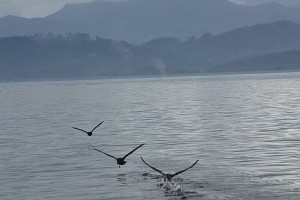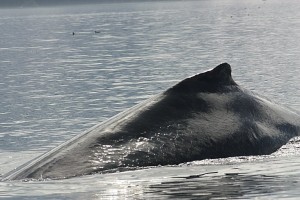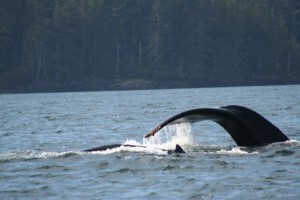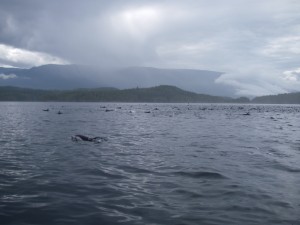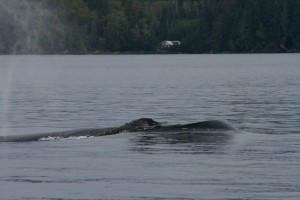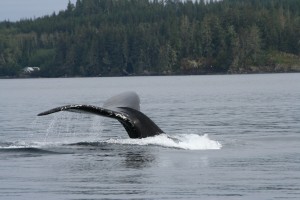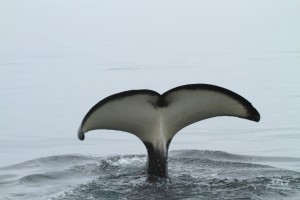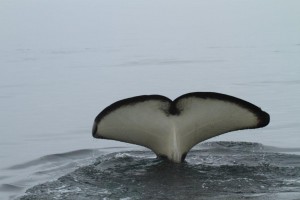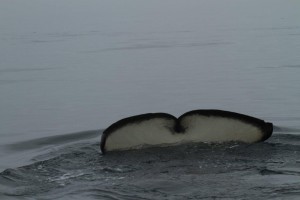Tag Archives: Whale Watching
Humpback whale dive
Is a good lens to get a close up picture of a humpback whale about to dive? The tell tail sign of a humpback whale about to dive and provide a opportunity for a picture of its tail is the thrust of its back higher out of the water as it noses down for a deep dive. A long telephoto lens is not a necessity as we normally have lunch with the whales. On our whale-watching safari, after a short bathroom break in Telegraph Cove on Vancouver Island, we head toward Bold Head an area frequented by humpback whales. Once there we cut the motors and drift while we have a picnic lunch. At this time it is not uncommon to have the whales come close enough to eliminate the need for long lenses in fact I have had guests comment that they could not get the whole whale in the photo. An excellent whale shot captures by UK’s Lynn Morris.
Humpback whale fluke
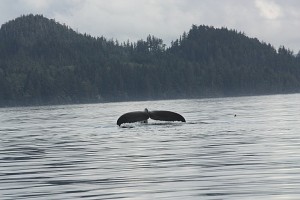
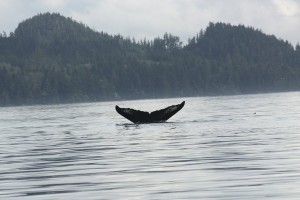 Lynn Morris from the UK provides these photos showing a humpback whale diving and showing the underside of it’s tail. The unique pattern on the tail is used to identify individual whales the same as the dorsal fin and saddle patch is used to identify the orca. The lodge’s whale watching safari area of Bold Head in Blackfish Sound normally contains eight or ten humpback whales, which feed on the herring in the area. The same herring attract the salmon, which in turn are the main attraction for the orca. It is not uncommon to be watching orca and whales at the same time, remembering these are the resident or salmon eating orca.
Lynn Morris from the UK provides these photos showing a humpback whale diving and showing the underside of it’s tail. The unique pattern on the tail is used to identify individual whales the same as the dorsal fin and saddle patch is used to identify the orca. The lodge’s whale watching safari area of Bold Head in Blackfish Sound normally contains eight or ten humpback whales, which feed on the herring in the area. The same herring attract the salmon, which in turn are the main attraction for the orca. It is not uncommon to be watching orca and whales at the same time, remembering these are the resident or salmon eating orca.
Humpback whale calf
Over the past five years humpback whales have become summer residents in the area we travel to look for killer whales (orca). The area of Johnstone Strait especially around Bold Head in Blackfish sound has become the summer home of humpback whales and their calves. It is common to view between eight and twelve whales on each trip from the lodge. The whale watching safari’s normally see orca, humpback whales, minke whales, sea lions, harbour seals, dolphins, harbour porpoise, dall’s porpoise, eagles and the occasional black bear.
Pacific white-sided dolphins
Whether on a whale watching safari to Johnstone Strait, grizzly bear trip up Knight Inlet or on the way to Trapper Rick’s on the Kakweikan River there is a chance to play with dolphins. Dolphins are spending their summers in our viewing area and at time in pods of several hundreds. They tend to be very active and to not shy away from boats in fact if you want to be left alone it is necessary to stop the boat and wait until they pass on to another area.
Humpback Whale diving
A good sequence of photos showing a humpback whale about to dive. While on our whale watching safari one of the photos guest want, beside killer whales, is a humpback diving and showing its tail. The tell in preparation for a dive is when the whale’s head comes a little higher out of the water than normal and then one gets the “hump” in the back as it noses down into deeper water, which throws the tail up. The next steps in the guides job is to maneuver the boat to be behind the whale when it dives and a photo of the underside of the tail.
Perfect day for pictures
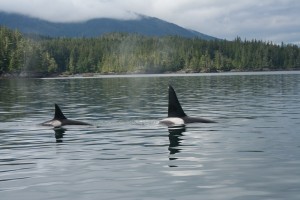 It does not matter what the subject of you photo, when you are on the water, you do not want a bright sunny day. Guests in the lodge are often upset as most mornings are overcast with the clouds burning off by noon. That is the nature of the north coast and that is good. Bright sun reflecting off the water makes for a poor picture whether of a grizzly bear on the shore, eagle in a tree or orca swimming. Most afternoons on the water are spent maneuvering the boat so the sun is at our backs to improve your chance of a good photo.
It does not matter what the subject of you photo, when you are on the water, you do not want a bright sunny day. Guests in the lodge are often upset as most mornings are overcast with the clouds burning off by noon. That is the nature of the north coast and that is good. Bright sun reflecting off the water makes for a poor picture whether of a grizzly bear on the shore, eagle in a tree or orca swimming. Most afternoons on the water are spent maneuvering the boat so the sun is at our backs to improve your chance of a good photo.
Humpback whale identification
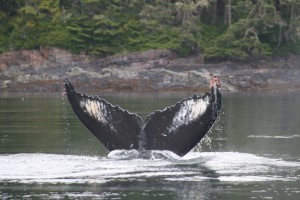 Humpback whales are identified by “Researchers (who) use photographs of the ventral surface of the tail flukes to identify and track movements of individual whales and to estimate abundance. Patterns of pigmentation, scarring and shape of the flukes are unique to each individual.” If you Google “Humpback whale identification” and scroll down to the Fisheries and Oceans Canada site titled “Photographic Catalogue of Humpback Whales in British Columbia” and once in the site scroll to “Photographs and data may not be used without permission. Please refer to “Conditions of Use”” and click on the Conditions of Use and you will have access to their catalogue identifying humpback whales in the lodges viewing area.
Humpback whales are identified by “Researchers (who) use photographs of the ventral surface of the tail flukes to identify and track movements of individual whales and to estimate abundance. Patterns of pigmentation, scarring and shape of the flukes are unique to each individual.” If you Google “Humpback whale identification” and scroll down to the Fisheries and Oceans Canada site titled “Photographic Catalogue of Humpback Whales in British Columbia” and once in the site scroll to “Photographs and data may not be used without permission. Please refer to “Conditions of Use”” and click on the Conditions of Use and you will have access to their catalogue identifying humpback whales in the lodges viewing area.
Orca dive Set 2 of 2
Orca dive Set 1 of 2
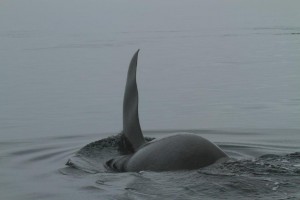
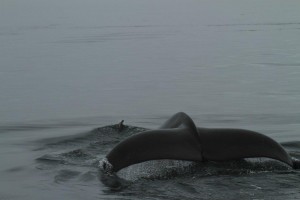
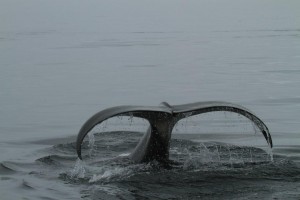 One of my favourite sequence or photos provided by Rob White from Australia. I told him I had to have a set of the photos and was so happy when he obliged with an email. The sequence shows an orca aka “killer whale” passing close to the boat and a guest with a good eye and a fast finger. I have never seen another set of photos like this and I have had many guests over the past twelve years.
One of my favourite sequence or photos provided by Rob White from Australia. I told him I had to have a set of the photos and was so happy when he obliged with an email. The sequence shows an orca aka “killer whale” passing close to the boat and a guest with a good eye and a fast finger. I have never seen another set of photos like this and I have had many guests over the past twelve years.
